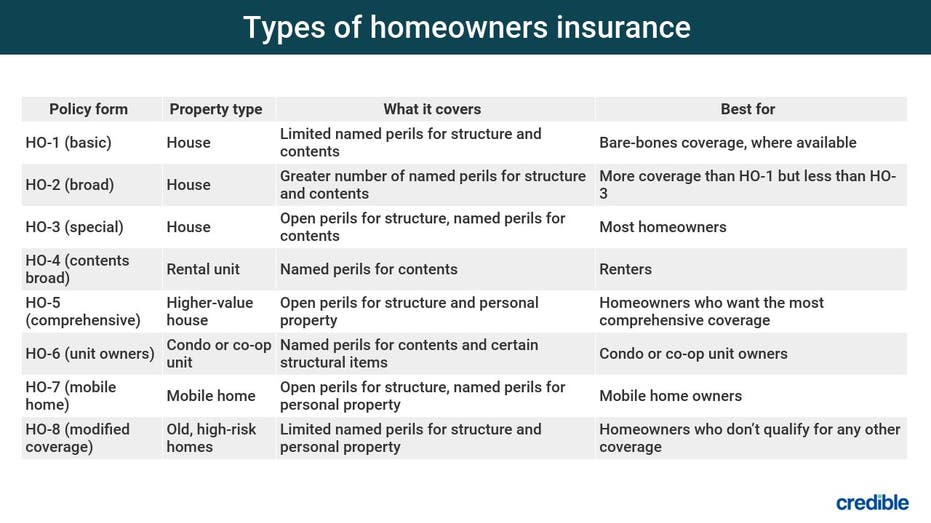What does an HO-3 insurance policy cover?
HO-3 home insurance is the most popular type of homeowners insurance, and it provides coverage in six different areas

If you just bought a home, you may want to opt for HO-3 insurance. Learn more about what it covers and how it differs from other policies. (Shutterstock)
Homeowners insurance policies come in several different forms, ranging from HO-1 to HO-8. The home insurance policy that’s best for you depends on the type of home you live in and the level of coverage you need. An HO-3 policy is the most common type of homeowners insurance, and it provides fairly comprehensive coverage.
Here’s what HO-3 insurance covers and how it compares with other home insurance policies.
With Credible, you can easily compare homeowners insurance rates from top insurance carriers.
- What is HO-3 insurance?
- Why do you need HO-3 insurance?
- HO-3 insurance coverages
- What doesn’t HO-3 insurance cover?
- How much does an average HO-3 policy cost?
- How much HO-3 insurance do you need?
- How is HO-3 insurance different from other policies?
- How to purchase an HO-3 home insurance policy
What is HO-3 insurance?
HO-3 insurance protects your home and other structures on your property, as well as personal belongings, against various perils — events that cause loss or damage to your home, such as a break-in or fire. This type of insurance also provides protection against personal liability claims and additional living expenses if you have to temporarily relocate (more on that later).
This homeowners insurance covers your home’s structure on an open-perils basis and your personal belongings on a named-perils basis. An open-perils policy covers all perils unless something is listed as an exclusion. By contrast, a named-perils policy covers only the perils listed in your policy.
HO-3 insurance typically covers your home against the following 16 perils:
- Windstorm or hail
- Fire or lightning
- Smoke
- Explosion
- Riot
- Theft
- Damage caused by aircraft
- Damage caused by vehicles
- Vandalism or malicious mischief
- Falling objects
- Weight of ice, snow, or sleet
- Accidental discharge or overflow of water from HVAC or home appliances
- Sudden and accidental tearing apart, cracking, burning, or bulging of systems
- Freezing of household appliances and systems, like your heater or AC
- Sudden and accidental damage from an artificially generated electrical current
- Volcanic eruption
Why do you need HO-3 insurance?
For starters, if you have a mortgage, your mortgage lender will likely require you to buy some type of homeowners insurance to protect its interest in your property. If you don’t have a policy or it lapses, your lender will purchase one for you — often at a much higher rate than you’d receive on your own — until you get insurance.
Even if you’re a mortgage-free homeowner, home insurance is still essential because it can protect your home and personal belongings against various unpredictable events. This can safeguard your hard-earned money since it limits your out-of-pocket expenses for covered damages.
WHAT IS EXTENDED REPLACEMENT COST FOR HOMEOWNERS INSURANCE?
HO-3 insurance coverages
An HO-3 policy usually provides you with coverages in these six areas:
- Dwelling coverage — If a covered peril damages your home’s structure, your insurance carrier will help cover the cost of repairs.
- Other structures coverage — Your policy also protects against damages to other structures on your property, like a fence or shed.
- Personal property coverage — HO-3 insurance covers your personal belongings from covered events.
- Additional living expenses coverage — If a windstorm or other covered risk makes your home uninhabitable, your insurance provider will help you pay for your additional living expenses, like your hotel bills and food.
- Personal liability coverage — If someone injures themselves on your property, or you or another person on your policy accidentally damage someone else’s property, your insurance can help if the person files a lawsuit against you.
- Medical payments coverage — This coverage helps pay for a certain amount of medical expenses for a guest who gets hurt on your property, regardless of whether they take legal action against you.
Visit Credible to get homeowners insurance quotes from multiple carriers in minutes.
What doesn’t HO-3 insurance cover?
Although an HO-3 insurance policy protects your home against a wide range of unfortunate events, it doesn’t cover everything.
Here are some events that standard home insurance often excludes:
- Flooding — Flooding is one of the most common natural disasters nationwide, but standard home insurance doesn’t provide flood coverage. However, you can purchase a separate flood insurance policy through the National Flood Insurance Program (NFIP) or a private insurer. If you have a federally backed mortgage and you live in a high-risk flood area, your lender will require you to purchase this type of insurance.
- Earth movement — If an earthquake, mudslide, or sinkhole damages your home, your insurance provider won’t pay for the damages. But you can purchase a separate earthquake insurance policy for added protection.
- Normal wear and tear — As time passes, it’s common for your home’s systems or materials (like your air conditioner and roofing materials) to need repairs or replacement. If normal wear and tear is the reason you have to repair or replace these items, your insurance carrier won’t cover the costs.
- Act of war — If an act of war destroys or damages your home, your insurance provider won’t pick up the tab.
- Sewer backup — Your insurer typically won’t pay to fix a sewer backup or any damage it causes.
HOW TO DECIDE IF YOU NEED FLOOD INSURANCE FOR YOUR HOME
How much does an average HO-3 policy cost?
The average cost of an HO-3 homeowners insurance across the U.S. in 2019 was $1,272 per year, or $106 per month, according to data from the National Association of Insurance Commissioners.
But the price you’ll pay for HO-3 insurance varies based on many factors, such as:
- Location
- Crime rate in your neighborhood
- Age of your home
- Deductible amount
- Your home’s replacement cost
- Distance from a fire station
- Your home’s safety features
- Your credit history (if your state uses credit-based insurance scores)
- Your claims history
- Amount of coverage
Your policy will also have a deductible. Your deductible is the amount you pay before your insurance kicks in. For instance, say your deductible is $2,000 and a heavy snowfall caves your roof in, causing $10,000 worth of damage. In this scenario, you’d have to pay $2,000 out of pocket, and your insurance provider would only pay $8,000 when you file an insurance claim.
If you choose a lower deductible, your insurance premium will be higher, but you’ll pay less out of pocket. To lower the cost of home insurance, you can raise your deductible. But the downside is you’ll have to pay more if something happens to your home.
How much HO-3 insurance do you need?
How much home insurance you need depends on several factors, such as the cost of rebuilding your home, the cost of replacing your personal belongings, and how much personal liability coverage you need.
It’s a good idea to purchase enough coverage to completely rebuild your home in case a fire or other covered peril destroys it. You should also consider making a list of your personal belongings, such as furniture, jewelry, and clothing, to determine how much coverage you need to replace those items. If you have any valuables, consider getting insurance riders (policy add-ons) for additional coverage.
To figure out how much personal liability coverage you need, calculate your net worth first. This is the total of all your assets. Consider getting enough coverage to protect the value of all your assets in the event someone sues you as a result of bodily harm at your home, or for property damage. You may want to get at least $300,000 to $500,000 worth of coverage, according to the Insurance Information Institute.
How is HO-3 insurance different from other policies?
Home insurance comes in eight different forms. While HO-3 insurance is a fairly comprehensive form of insurance, it doesn’t offer as much coverage as an HO-5 policy.
Here’s a closer look at what each form usually covers:

How to purchase an HO-3 home insurance policy
If you’re ready to buy homeowners insurance, take these steps:
- Figure out what type of coverage you need. Choose the home insurance option that’s right for the structure of your home. For example, if you own a condo, you should select HO-6 insurance.
- Calculate how much coverage you need. Figure out how much coverage you’ll need to replace your dwelling and belongings if your home gets destroyed. Remember to also get enough personal liability coverage to protect your assets. To easily estimate your home’s replacement cost value, multiply your home’s total square footage by the per-square-foot cost to rebuild a home in your area. An insurance agent or appraiser can help you get a more accurate number.
- Shop around. To find a policy that matches your needs and budget, get quotes from at least three to five insurance providers. When comparing quotes, make sure they’re for similar coverages.
- Choose and purchase your policy. After you’ve found the right insurance carrier, select the amount of coverage you need and proceed with purchasing your policy.
Credible makes comparison shopping for homeowners insurance easy. Get quotes from top insurance carriers, all in one place.